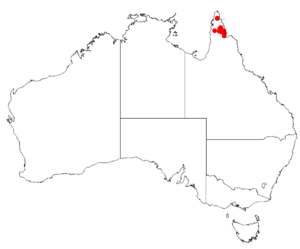Boronia squamipetala facts for kids
Quick facts for kids Boronia squamipetala |
|
|---|---|
| Scientific classification | |
| Genus: |
Boronia
|
| Species: |
squamipetala
|
 |
|
| Occurrence data from Australasian Virtual Herbarium | |
Boronia squamipetala is a special kind of plant. It belongs to the citrus family, which is called Rutaceae. You can only find this plant growing naturally in Queensland, Australia. It's a shrub that stands upright, meaning it grows straight up.
Its leaves look a bit like feathers, with many small parts called leaflets. Each leaf has between five and thirteen oval-shaped leaflets. The flowers are green to white and have four petals. The backs of these petals feel a bit hairy.
Contents
What Does Boronia squamipetala Look Like?
Boronia squamipetala is a shrub that grows upright. It can reach about 1 meter (3 feet) tall. Its branches are somewhat square when you look at them from the side. They also have tiny hairs that look like stars.
The leaves are made up of smaller parts called leaflets. There are usually between five and thirteen oval-shaped leaflets on each leaf. The whole leaf, including its stalk (called a petiole), is about 33 to 55 millimeters long and 12 to 20 millimeters wide. The stalk itself is about 6 to 15 millimeters long. The leaflet at the very end of the leaf is usually 8 to 20 millimeters long. The leaflets on the sides are a bit smaller, about 3 to 13 millimeters long.
The flowers grow on short stalks. The main flower stalk is about 1 to 2 millimeters long. Each individual flower has its own tiny stalk, about 2 to 6 millimeters long. There are four green, leaf-like parts called sepals at the base of the flower. They are about 2 millimeters long and have hairy backs. These sepals grow bigger as the fruit develops.
The four petals are green to white. They are about 4 to 7 millimeters long and 2.5 to 4 millimeters wide. Like the sepals, they also grow bigger as the fruit forms and have hairy backs. Inside the flower, there are eight stamens, which are the parts that produce pollen. They are different lengths.
This plant usually flowers from May to October. After flowering, it produces a smooth, dry fruit called a capsule. This capsule is about 4 to 5.5 millimeters long and 2.5 to 3 millimeters wide.
How Was It Named?
The plant Boronia squamipetala was officially described in 1999. This description was made by a scientist named Marco F. Duretto. It was published in a science journal called Austrobaileya.
The second part of its name, squamipetala, tells us something special about the plant. It means "scaly petals." This is because if you look closely at the petals with a magnifying glass, they appear to have tiny scales.
Where Does Boronia squamipetala Grow?
This type of boronia plant grows in different natural areas. You can find it in woodlands, forests, and open heathlands. It mainly grows on the Cape York Peninsula in Queensland, Australia. Specifically, it's found in places like the Iron Range and the McIlwraith Range.
Is Boronia squamipetala Protected?
The Queensland Government has a law called the Nature Conservation Act 1992. Under this law, Boronia squamipetala is listed as "least concern." This means that the plant is not currently at risk of disappearing. It is considered to be safe and common enough in its natural habitat.

